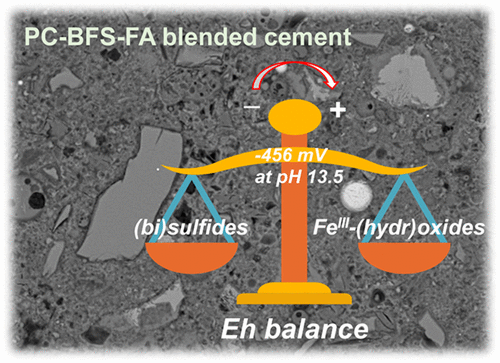当前位置:
X-MOL 学术
›
Environ. Sci. Technol.
›
论文详情
Our official English website, www.x-mol.net, welcomes your
feedback! (Note: you will need to create a separate account there.)
Selenite Sorption on Hydrated CEM-V/A Cement in the Presence of Steel Corrosion Products: Redox vs Nonredox Sorption.
Environmental Science & Technology ( IF 10.8 ) Pub Date : 2020-01-23 , DOI: 10.1021/acs.est.9b06876 Bin Ma 1, 2 , Alejandro Fernandez-Martinez 1 , Kaifeng Wang 1, 3 , Benoît Madé 4 , Pierre Hénocq 4 , Delphine Tisserand 1 , Sarah Bureau 1 , Laurent Charlet 1
Environmental Science & Technology ( IF 10.8 ) Pub Date : 2020-01-23 , DOI: 10.1021/acs.est.9b06876 Bin Ma 1, 2 , Alejandro Fernandez-Martinez 1 , Kaifeng Wang 1, 3 , Benoît Madé 4 , Pierre Hénocq 4 , Delphine Tisserand 1 , Sarah Bureau 1 , Laurent Charlet 1
Affiliation

|
Reinforced cementitious structures in nuclear waste repositories will act as barriers that limit the mobility of radionuclides (RNs) in case of eventual leakage. CEM-V/A cement, a ternary blended cement with blast furnace slag (BFS) and fly ash (FA), could be qualified and used in nuclear waste disposal. Chemical interactions between the cement and RNs are critical but not completely understood. Here, we combined wet chemistry methods, synchrotron-based X-ray techniques, and thermodynamic modeling to explore redox interactions and nonredox sorption processes in simulated steel-reinforced CEM-V/A hydration systems using selenite as a molecular probe. Among all of the steel corrosion products analyzed, only the addition of Fe0 can obviously enhance the reducing ability of cement toward selenite. In comparison, steel corrosion products showed stronger reducing power in the absence of cement hydrates. Selenium K-edge X-ray absorption spectroscopy (XAS) revealed that selenite immobilization mechanisms included nonredox inner-/outer-sphere complexations and reductive precipitations of FeSe and/or Se(0). Importantly, the hydrated pristine cement showed a good reducing ability, driven by ferrous phases and (bi)sulfides (as shown by sulfur K-edge XAS) originated from BFS and FA. The overall redox potential imposed by hydrated CEM-V/A was determined, hinting to a redox shift in underground cementitious structures.
中文翻译:

在钢腐蚀产物存在下,在水合CEM-V / A水泥上的亚硒酸盐吸附:氧化还原与非氧化还原吸附。
核废料储存库中的加固水泥结构将充当障碍,以防万一最终泄漏时限制放射性核素(RNs)的迁移。CEM-V / A水泥是具有高炉矿渣(BFS)和粉煤灰(FA)的三元混合水泥,可以用于核废料处理。水泥与RN之间的化学相互作用至关重要,但尚未完全了解。在这里,我们结合了湿化学方法,基于同步加速器的X射线技术和热力学模型,以模拟的钢强化CEM-V / A水化系统(以亚硒酸盐为分子探针)探索了氧化还原相互作用和非氧化还原吸附过程。在所有分析的钢腐蚀产物中,仅添加Fe0即可明显提高水泥对亚硒酸盐的还原能力。相比下,在没有水泥水合物的情况下,钢腐蚀产物显示出更强的还原能力。硒K边缘X射线吸收光谱法(XAS)显示,亚硒酸盐固定化机制包括非氧化还原内外球面络合物以及FeSe和/或Se(0)的还原性沉淀。重要的是,水化的原始水泥显示出良好的还原能力,这是由源自BFS和FA的亚铁相和(bi)硫化物(如硫K-edge XAS所示)驱动的。确定了水合CEM-V / A施加的总体氧化还原电势,暗示了地下水泥结构中的氧化还原移动。硒K边缘X射线吸收光谱法(XAS)显示,亚硒酸盐固定化机制包括非氧化还原内外球面络合物以及FeSe和/或Se(0)的还原性沉淀。重要的是,水化的原始水泥显示出良好的还原能力,这是由源自BFS和FA的亚铁相和(bi)硫化物(如硫K-edge XAS所示)驱动的。确定了水合CEM-V / A施加的总体氧化还原电势,暗示了地下水泥结构中的氧化还原移动。硒K边缘X射线吸收光谱法(XAS)显示,亚硒酸盐固定化机制包括非氧化还原内外球面络合物以及FeSe和/或Se(0)的还原性沉淀。重要的是,水化的原始水泥显示出良好的还原能力,这是由源自BFS和FA的亚铁相和(bi)硫化物(如硫K-edge XAS所示)驱动的。确定了水合CEM-V / A施加的总体氧化还原电势,暗示了地下水泥结构中的氧化还原移动。
更新日期:2020-02-06
中文翻译:

在钢腐蚀产物存在下,在水合CEM-V / A水泥上的亚硒酸盐吸附:氧化还原与非氧化还原吸附。
核废料储存库中的加固水泥结构将充当障碍,以防万一最终泄漏时限制放射性核素(RNs)的迁移。CEM-V / A水泥是具有高炉矿渣(BFS)和粉煤灰(FA)的三元混合水泥,可以用于核废料处理。水泥与RN之间的化学相互作用至关重要,但尚未完全了解。在这里,我们结合了湿化学方法,基于同步加速器的X射线技术和热力学模型,以模拟的钢强化CEM-V / A水化系统(以亚硒酸盐为分子探针)探索了氧化还原相互作用和非氧化还原吸附过程。在所有分析的钢腐蚀产物中,仅添加Fe0即可明显提高水泥对亚硒酸盐的还原能力。相比下,在没有水泥水合物的情况下,钢腐蚀产物显示出更强的还原能力。硒K边缘X射线吸收光谱法(XAS)显示,亚硒酸盐固定化机制包括非氧化还原内外球面络合物以及FeSe和/或Se(0)的还原性沉淀。重要的是,水化的原始水泥显示出良好的还原能力,这是由源自BFS和FA的亚铁相和(bi)硫化物(如硫K-edge XAS所示)驱动的。确定了水合CEM-V / A施加的总体氧化还原电势,暗示了地下水泥结构中的氧化还原移动。硒K边缘X射线吸收光谱法(XAS)显示,亚硒酸盐固定化机制包括非氧化还原内外球面络合物以及FeSe和/或Se(0)的还原性沉淀。重要的是,水化的原始水泥显示出良好的还原能力,这是由源自BFS和FA的亚铁相和(bi)硫化物(如硫K-edge XAS所示)驱动的。确定了水合CEM-V / A施加的总体氧化还原电势,暗示了地下水泥结构中的氧化还原移动。硒K边缘X射线吸收光谱法(XAS)显示,亚硒酸盐固定化机制包括非氧化还原内外球面络合物以及FeSe和/或Se(0)的还原性沉淀。重要的是,水化的原始水泥显示出良好的还原能力,这是由源自BFS和FA的亚铁相和(bi)硫化物(如硫K-edge XAS所示)驱动的。确定了水合CEM-V / A施加的总体氧化还原电势,暗示了地下水泥结构中的氧化还原移动。











































 京公网安备 11010802027423号
京公网安备 11010802027423号